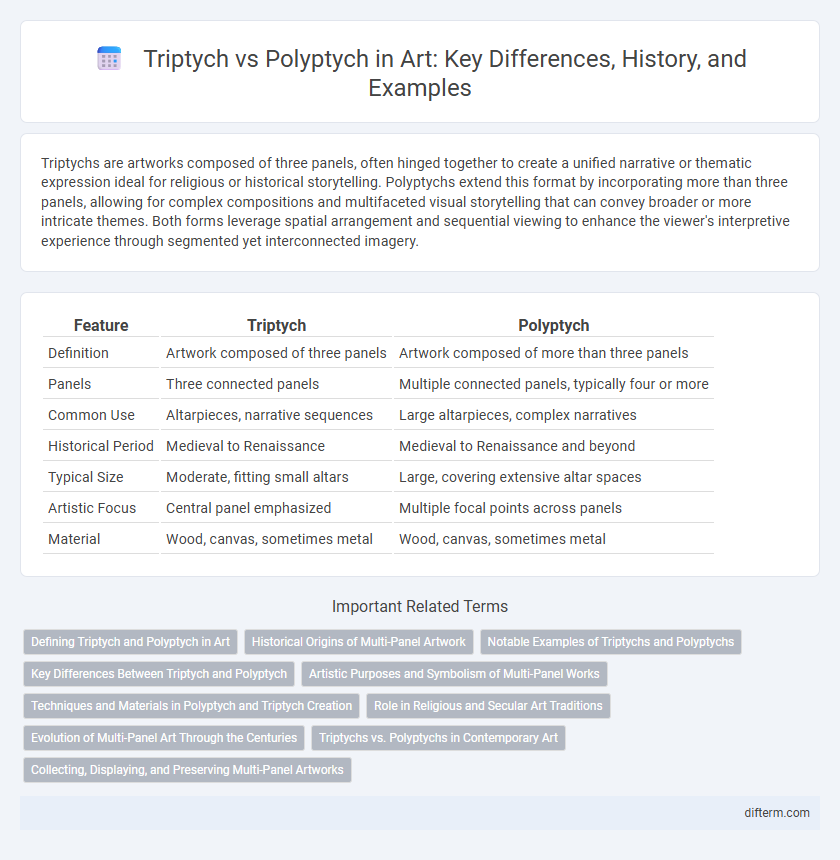Triptychs are artworks composed of three panels, often hinged together to create a unified narrative or thematic expression ideal for religious or historical storytelling. Polyptychs extend this format by incorporating more than three panels, allowing for complex compositions and multifaceted visual storytelling that can convey broader or more intricate themes. Both forms leverage spatial arrangement and sequential viewing to enhance the viewer's interpretive experience through segmented yet interconnected imagery.
Table of Comparison
| Feature | Triptych | Polyptych |
|---|---|---|
| Definition | Artwork composed of three panels | Artwork composed of more than three panels |
| Panels | Three connected panels | Multiple connected panels, typically four or more |
| Common Use | Altarpieces, narrative sequences | Large altarpieces, complex narratives |
| Historical Period | Medieval to Renaissance | Medieval to Renaissance and beyond |
| Typical Size | Moderate, fitting small altars | Large, covering extensive altar spaces |
| Artistic Focus | Central panel emphasized | Multiple focal points across panels |
| Material | Wood, canvas, sometimes metal | Wood, canvas, sometimes metal |
Defining Triptych and Polyptych in Art
A triptych in art is a three-panel work, often hinged together to form a cohesive narrative or thematic scene, traditionally used in altarpieces. A polyptych expands on this format with more than three panels, allowing for complex storytelling through multiple interconnected images. Both formats emphasize spatial organization and continuity, enhancing visual and symbolic depth in artistic compositions.
Historical Origins of Multi-Panel Artwork
Triptychs originated in early Christian art, primarily used as altarpieces in Byzantine and medieval European churches, consisting of three hinged panels. Polyptychs evolved from triptychs, expanding to multiple panels beyond three, becoming popular during the Gothic and Renaissance periods for complex narrative displays. These multi-panel artworks served both liturgical functions and storytelling purposes, reflecting artistic and theological developments across centuries.
Notable Examples of Triptychs and Polyptychs
Notable examples of triptychs include Hieronymus Bosch's "The Garden of Earthly Delights" and Robert Campin's "Merode Altarpiece," both showcasing three-panel compositions that emphasize religious narratives. Prominent polyptychs such as Jan van Eyck's "Ghent Altarpiece" and Rogier van der Weyden's "Descent from the Cross" feature multiple interconnected panels offering complex, continuous storytelling across several images. These works illustrate the distinction between triptychs as three-paneled altarpieces and polyptychs as multi-paneled artworks, both pivotal in Christian religious art.
Key Differences Between Triptych and Polyptych
Triptych and polyptych are distinct forms of multi-panel artwork primarily differentiated by the number of panels; a triptych consists of three panels, often hinged together, while a polyptych includes four or more panels, creating a more complex visual narrative. The triptych typically centers on a single thematic story divided across its three segments, whereas polyptychs offer an extended, often more detailed exploration of religious or historical scenes through multiple interconnected panels. Both formats have been widely used in medieval and Renaissance altarpieces, showcasing their significance in religious and artistic contexts.
Artistic Purposes and Symbolism of Multi-Panel Works
Triptychs and polyptychs serve distinct artistic purposes by dividing a narrative or thematic concept across multiple panels, enhancing storytelling and symbolic depth in visual art. Triptychs, typically comprising three panels, often represent a central theme flanked by complementary scenes, symbolizing balance and progression, while polyptychs extend this complexity with numerous panels to depict intricate religious or historical narratives. The multi-panel format encourages viewer engagement through sequential interpretation, emphasizing spiritual contemplation and the interplay of individual elements within a unified composition.
Techniques and Materials in Polyptych and Triptych Creation
Triptychs and polyptychs differ significantly in techniques and materials, with triptychs typically consisting of three panels joined by hinges, allowing them to fold and creating a dynamic narrative sequence. Polyptychs extend this concept with multiple panels, requiring advanced structural supports and precise joinery to maintain stability and coherence across numerous sections. Artists often employ oil paint on wood or canvas, integrating gilding, tempera, and mixed media to enhance texture and depth in both formats, while the mounting and framing techniques are tailored to accommodate the complex arrangement of multiple panels in polyptychs.
Role in Religious and Secular Art Traditions
Triptychs, typically consisting of three panels, were pivotal in medieval Christian art for altarpieces, conveying complex religious narratives through a central image flanked by two related scenes. Polyptychs expand this format with multiple panels, allowing for more elaborate storytelling and detailed iconographic arrangements, often found in large church settings and Renaissance secular commissions. Both forms serve as powerful visual tools that bridge devotional purposes and artistic expression, emphasizing theological themes while accommodating evolving artistic styles in sacred and non-sacred contexts.
Evolution of Multi-Panel Art Through the Centuries
Triptych and polyptych represent key forms in the evolution of multi-panel art, with triptychs featuring three panels and polyptychs extending to four or more, reflecting increasing complexity in narrative and spatial arrangement. Originating in medieval Christian altarpieces, these formats evolved through the Renaissance and Baroque periods, incorporating intricate iconography and enhanced realism. Contemporary artists continue to experiment with multi-panel compositions, blending traditional techniques with modern themes to explore fragmented perspectives and dynamic storytelling.
Triptychs vs. Polyptychs in Contemporary Art
Triptychs in contemporary art emphasize a cohesive narrative or theme spread across three panels, creating a focused and intimate visual dialogue. Polyptychs expand this concept to multiple panels, allowing for complex, multifaceted stories or abstract explorations that engage viewers through varied perspectives and spatial dynamics. Both formats offer artists versatile structures to experiment with composition, scale, and thematic development, influencing contemporary visual storytelling methods.
Collecting, Displaying, and Preserving Multi-Panel Artworks
Collecting triptychs and polyptychs requires careful consideration of their multi-panel structure, ensuring provenance, condition, and cohesive narrative are intact. Displaying these artworks demands specialized mounting systems that maintain alignment and allow for optimal lighting to highlight each panel's detail. Preserving multi-panel artworks involves climate control to prevent warping, regular inspection of hinges or joins, and expert conservation to sustain the integrity of the entire composition.
Triptych vs Polyptych Infographic

 difterm.com
difterm.com